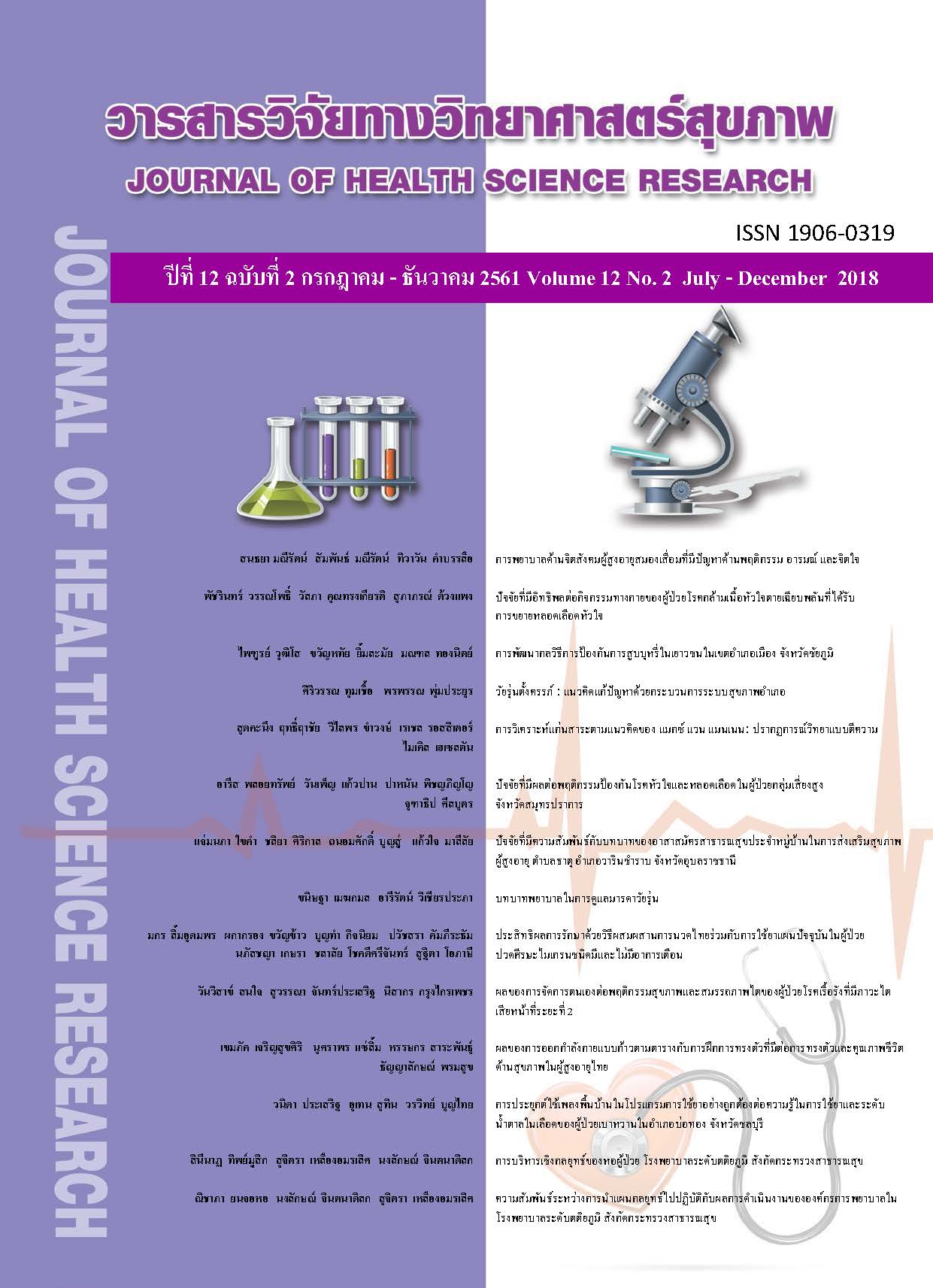การพัฒนากลวิธีการป้องกันการสูบบุหรี่ในเยาวชนในเขตอำเภอเมือง จังหวัดชัยภูมิ
Main Article Content
บทคัดย่อ
การวิจัยครั้งนี้มีวัตถุประสงค์ เพื่อศึกษากลวิธีและพัฒนากลวิธีการป้องกันการสูบบุหรี่ในเยาวชนในเขตอำเภอเมือง จังหวัดชัยภูมิ วิธีการศึกษาใช้รูปแบบการวิจัยแบบบูรณาการ กลุ่มตัวอย่างเป็นเยาวชน นักวิชาการ และผู้ทรงคุณวุฒิ เก็บข้อมูลโดยการใช้แบบสอบถาม การสนทนากลุ่ม และการสัมภาษณ์เชิงลึก วิเคราะห์ข้อมูลด้วยสถิตเชิงพรรณนา และ t-test
ผลการวิจัยพบว่า 1) การรับรู้สมรรถนะของตนเองในการป้องกันการสูบบุหรี่ในภาพรวม อยู่ในระดับมาก ( = 4.09 SD = 1.08) ความรู้เกี่ยวกับการสูบบุหรี่มีคะแนนมากกว่าร้อยละ 60.00 คิดเป็นร้อยละ 97.25 ทักษะการตัดสินใจเพื่อป้องกัน การสูบบุหรี่มีค่าสูงที่สุดคิดเป็นร้อยละ 86.50 และทักษะการปฏิเสธเพื่อป้องกันการสูบบุหรี่มีค่าสูงที่สุดคิดเป็นร้อยละ 87.00 2)กระบวนการพัฒนากลวิธีการป้องกันการสูบบุหรี่ ควรประกอบด้วย การตัดสินใจ การวางแผน การปฏิบัติตามแผน ประเมินผลงาน และการปรับปรุงและร่วมพัฒนา และกลวิธีการป้องกันการสูบบุหรี่ควรประกอบด้วย การป้องกันเชิงรุกที่มุ่งเน้นปัจจัยภายในตัวเยาวชนและปัจจัยด้านสิ่งแวดล้อมรอบตัวเยาวชน 3) เยาวชนมีระดับความคิดเห็นที่ได้มีส่วนร่วมในกระบวนการ พัฒนากลวิธีการป้องกันการสูบบุหรี่ ในภาพรวมอยู่ในระดับมาก (
= 3.92 SD = 0.67) และหลังเสร็จสิ้นการวิจัย ค่าเฉลี่ยทักษะการตัดสินใจเพื่อป้องกันการสูบบุหรี่และค่าเฉลี่ยทักษะการปฏิเสธเพื่อป้องกันการสูบบุหรี่ของเยาวชนมากกว่าก่อนการดำเนินการวิจัย อย่างมีนัยสำคัญทางสถิติ 4) เยาวชนเห็นว่ากระบวนการพัฒนากลวิธีการป้องกันการสูบบุหรี่มีความเหมาะสมในภาพรวม อยู่ในระดับมาก (
= 3.79, SD = 0.81) และ 5) กลวิธีการป้องกันการสูบบุหรี่มีความเหมาะสม ในภาพรวมอยู่ในระดับมาก (
= 4.15, SD = 0.84) ซึ่งการพัฒนากลวิธีการป้องกันการสูบบุหรี่ในเยาวชนให้ประสบความสำเร็จต้องคำนึงปัจจัยทั้งภายในและภายนอกตัวบุคคล โดยอาศัยการทำงานเชิงรุกและการมีส่วนร่วมของเยาวชน
Downloads
Article Details
บทความที่ได้รับการตีพิมพ์เป็นลิขสิทธิ์ของวิทยาลัยพยาบาลบรมราชชนนี จังหวัดนนทบุรี
ข้อความที่ปรากฏในบทความแต่ละเรื่องในวารสารวิชาการเล่มนี้เป็นความคิดเห็นส่วนตัวของผู้เขียนแต่ละท่านไม่เกี่ยวข้องกับวิทยาลัยพยาบาลบรมราชชนนี จังหวัดนนทบุรี และคณาจารย์ท่านอื่น ในวิทยาลัยฯ แต่อย่างใด ความรับผิดชอบองค์ประกอบทั้งหมดของบทความแต่ละเรื่องเป็นของผู้เขียนแต่ละท่าน หากมีความผิดพลาดใด ๆ ผู้เขียนแต่ละท่านจะรับผิดชอบบทความของตนเองแต่ผู้เดียว
References
2.Termsirikulchai L, Benjakul S. The situation of tobacco consumption. In: Wattanasirichai S, editor. Health textbooks tobacco control for health professionals and students. Bangkok: Thai Health Professional Alliance Against Tobacco; 2007. p. 63-102. (in Thai).
3.National Statistical Office. Smoking behavior survey and alcohol consumption of the population in 2014 [Internet]. 2015 [cited 2016 Nov 11]; Available from: http://service.nso.go.th/nso/nsopublish/themes/files/smokePocket57.pdf. (in Thai).
4.Thevejcharoenchai S. Drugs and drug addicts. Bangkok: Thai Wattana Panich; 1997. (in Thai).
5.Clayton S. Gender differences in psychosocial determinants of adolescent smoking. J Sch Health. 1991;61(3):115-20.
6.Lewis PC, Harrell JS, Bradley C, Deng S. Cigarette use in adolescents: The cardiovascular health in children and youth study. Res Nurs Health. 2001;24(1): 27-37.
7.Glendinning A. Self-esteem and smoking in youth--muddying the water? J Adolesc. 2002;25(4):415-25.
8.Lohakit S. Smoking attitude of Chiang Mai University and Mea Jo University freshmen data analysis [Thesis]. Chiang Mai: Chiang Mai University; 2005. (in Thai).
9.Kum-ngern P. Opinion on motivating factors that led the undergraduate students at the school of tourism development, Maejo University, Chiang Mai to smoking [Internet]. 2010 [cited 2012 Nov 11]; Available from: http://www.tourism.mju.ac.th/ download/research/7.pdf . (in Thai).
10. Tongbai W, Puyadow C, Thanomegurn R. Factors affecting relapsed smokers participating in smoking cessation project Khammuang Hospital. Research and Development Health System Journal. 2011;3:1-8.(in Thai).
11.Thuansri Y, Oonjan S. Mechanism to reduce access to cigarettes of male students paticipartory of Uttaradit Rajabhat University. Lampang Rajabhat University Journal. 2016;5(1):28-40. (in Thai).
12.Pittayarangsarit S, Anan P, Pankrachang P, Sommit K. The summary of tobacco consumption control in Thailand 2012. Bangkok: Charoen Di Mankhong Kanpim; 2012. (in Thai).
13.National Health Interview Survey. QuickStats: Assistance used to quit smoking by adults aged ≥ 18 years* during the preceding 2 years, by type [Internet]. 2005 [cited 2011 Jun 11]; Available from: https://www.cdc.gov/mmwr/preview/mmwrhtml/mm5620a5.htm. (in Thai).
14.Chantachum W. Development of student smoking prevention strategies using participatory processes: A case study of Kalasin Province Opportunity School. Journal of Behavioral Sciences. 2006;12(1):94-109. (in Thai).
15.The Secretariat of The House of Representatives. Constitution of the Kingdom of Thailand, B.E. 2550. Bangkok: Bureau of Printing Services, The Secretariat of The House of Representatives; 2007. (in Thai).
16.Vutiso P, Yimlamai K, Thongnit M, Khunkhavan T. A community participation model of tobacco accessibility prevention for youth in Muang District, Chaiyaphum Province. Thai Journal of Nursing. 2013;62(1):12-21. (in Thai).
17.Tahlil T, Woodman RJ, Coveney J, Ward PR. The impact of education programs on smoking prevention: A randomized controlled trial among 11 to 14 year olds in Aceh, Indonesia. BMC Public Health. 2013;13:367.
18.Huda Waehayee H, Chaichana B, Ruangdej K. Effectiveness of a life skill training program on perceived self efficacy for the prevention of smoking among the first year students at Yala Rajabhat University. Nursing Journal of the Ministry of Public Health. 2012;22(1):85-97. (in Thai).

